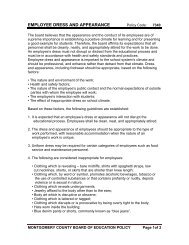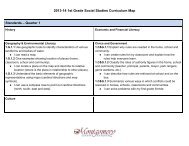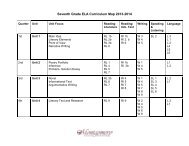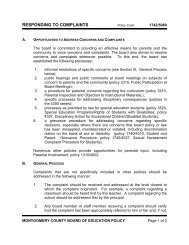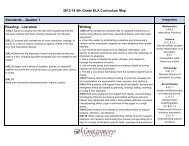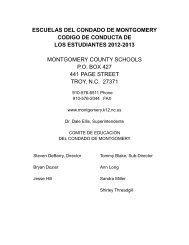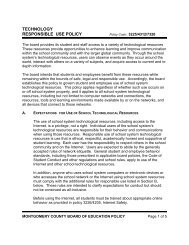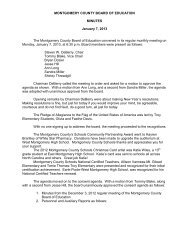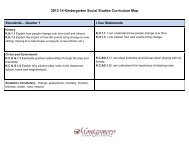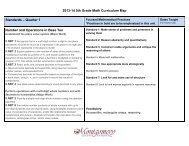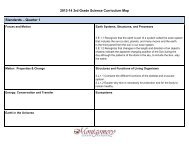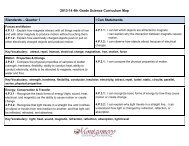2013-14 4th Grade Social Studies Curriculum Map Standards ...
2013-14 4th Grade Social Studies Curriculum Map Standards ...
2013-14 4th Grade Social Studies Curriculum Map Standards ...
You also want an ePaper? Increase the reach of your titles
YUMPU automatically turns print PDFs into web optimized ePapers that Google loves.
<strong>2013</strong>-<strong>14</strong> <strong>4th</strong> <strong>Grade</strong> <strong>Social</strong> <strong>Studies</strong> <strong>Curriculum</strong> <strong>Map</strong><br />
<strong>Standards</strong> – Quarter 1<br />
History<br />
4.H.1.1 Summarize the change in cultures, everyday life & status of<br />
indigenous American Indian groups in NC before & after European<br />
exploration.<br />
4.H.1.2 Explain how and why NC was established.<br />
4.H.1.3 Explain how people, events & developments brought about<br />
changes to communities in various regions of NC.<br />
4.H.1.4 Analyze NC’s role in major conflicts & wars from the Pre-<br />
Colonial period through Reconstruction.<br />
Academic Vocabulary<br />
change, Colonialism, immigration, plantation, politics, historical<br />
significance<br />
Geography & Environmental Literacy<br />
4.G.1.1 Summarize changes that have occurred in North Carolina<br />
since statehood (population growth, transportation, communication,<br />
and land use).<br />
4.G.1.2 Explain the impact that human activity has on the availability<br />
of natural resources in North Carolina.<br />
4.G.1.3 Exemplify the interactions of various peoples, places, and<br />
cultures in terms of adaptation and modification of the environment.<br />
4.G.1.4 Explain the impact of technology (communication,<br />
transportation, and inventions) on North Carolina’s citizens, past and<br />
present.<br />
geography, regions, cape, natural resources, conservation, relative<br />
location, absolute location, legend, compass rose, scale, barrier<br />
islands, climate, elevation, sound, fall line, mineral erosion, wetland,<br />
pollution, rural, reservoir, culture, port, plateau, urban,<br />
Piedmont, Mountain, Coastal Region
<strong>Standards</strong> – Quarter 2<br />
<strong>2013</strong>-<strong>14</strong> <strong>4th</strong> <strong>Grade</strong> <strong>Social</strong> <strong>Studies</strong> <strong>Curriculum</strong> <strong>Map</strong><br />
Academic Vocabulary<br />
History<br />
4.H.2.1 Explain why important buildings, statues, monuments &<br />
place names are associated with the state’s history.<br />
4.H.2.2 Explain the historical significance of NC’s state symbols.<br />
representation<br />
leadership<br />
symbols<br />
Civics and Government<br />
4.C&G.1.1 Summarize the key principles & revisions of the NC<br />
Constitution.<br />
4.C&G.1.2 Compare the roles & responsibilities of state elected<br />
leaders.<br />
4.C&G.1.3 Explain the influence of the colonial history of NC on the<br />
governing documents of our state.<br />
4.C&G.1.4 Compare NC’s government with local governments.<br />
4.C&G.2.1 Analyze the preamble & articles of the NC Constitution in<br />
terms of rights & responsibilities.<br />
4.C&G.2.2 Give examples of rights & responsibilities of citizens<br />
according to NC Constitution.<br />
4.C&G.2.3 Differentiate between rights and responsibilities reflected<br />
in the NC Constitution.<br />
civics, government, governance, elections, capitol, public servants,<br />
veto, law, county, mayor, patriot, loyalist, delegate, independence,<br />
petition, surrender, constitution, conflict, Stamp Act,congress,<br />
revolution, legislature
<strong>2013</strong>-<strong>14</strong> <strong>4th</strong> <strong>Grade</strong> <strong>Social</strong> <strong>Studies</strong> <strong>Curriculum</strong> <strong>Map</strong><br />
<strong>Standards</strong> – Quarter 3<br />
Economic and Financial Literacy<br />
4.E.1.1 Understand the basic concepts of market economy: price,<br />
supply, demand, scarcity, productivity, & entrepreneurship.<br />
4.E.1.2 Understand how scarcity & choice in a market economy<br />
impacts business decisions.<br />
4.E.1.3 Analyze the historical & contemporary role that major NC<br />
industries have played in the state, nation, and world.<br />
4.E.1.4 Explain the impact of entrepreneurship on the economy of<br />
NC.<br />
4.E.2.1 Explain how personal financial decisions such as spending,<br />
saving, and paying taxes can positively and/or negatively affect<br />
everyday life.<br />
4.E.2.2 Explain how scarcity of personal financial resources affect<br />
the choices people make based on their wants and needs.<br />
Academic Vocabulary<br />
market economy, supply, demand, scarcity, productivity,<br />
entrepreneurship, goods, services, consumers, economy
<strong>Standards</strong> – Quarter 4<br />
<strong>2013</strong>-<strong>14</strong> <strong>4th</strong> <strong>Grade</strong> <strong>Social</strong> <strong>Studies</strong> <strong>Curriculum</strong> <strong>Map</strong><br />
Academic Vocabulary<br />
Culture<br />
4.C.1.1 Explain how the settlement of people from various cultures<br />
affected the development of regions in NC ( language, foods, and<br />
traditions).<br />
4.C.1.2 Explain how the artistic expression of various groups<br />
represents the cultural heritage of NC.<br />
culture, diversity, values, beliefs, customs, traditions, celebrations, heritage,<br />
cultural vs. physical differences, society, influence, impact<br />
,,



